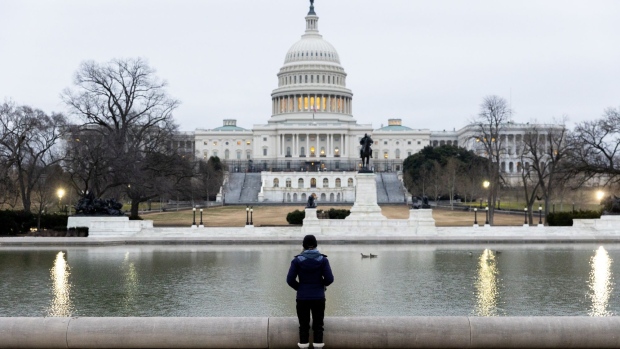Feb 16, 2022
Wall Street Is Back in Office While Its Regulators Stay Home
, Bloomberg News

(Bloomberg) -- While Wall Street banks press employees to return to the office this month, its regulators in Washington are largely sticking with a flexible approach to remote work.
The U.S. Securities and Exchange Commission, which has a staff of about 4,500, pushed back until June 6 its earliest date for requiring employees to return, according to a person familiar with the plans. The Federal Reserve in Washington remains mostly in a remote posture, and at the Office of the Comptroller of the Currency, no final decision has been made on when workers will be called back on a mandatory basis.
At other agencies across the government, employees are largely still working from home. Meanwhile, financial giants from Citigroup Inc. to Goldman Sachs Group Inc. have pressed to bring back staff this month after a nationwide surge in coronavirus cases at the end of last year and in the early weeks of this year.
The difference between the two largely reflects the nature of their work, concentration of unionized workers and flexible-work cultures even before the pandemic hit.
“Financial firms particularly -- but really all businesses -- must react quickly to changes in market conditions. It’s difficult to do if the people whose judgment you want are not immediately accessible, at their desks, on the same floor, receiving the same information,” said Peter Wallison, a senior fellow emeritus at the American Enterprise Institute.
“Government work, apart from political or emergency responses, does not generally require immediate decisions,” said Wallison, who was general counsel of the Treasury and White House counsel in the Reagan administration. “That’s why the government can afford to have workers at remote sites like their homes, while businesses cannot.”
Union Negotiations
Another distinction are labor contracts. The federal government is made up of political appointees, who change from administration to administration, and civil servants. Those career employees enjoy legal protections that prevent them from being fired at will.
At most of the federal financial regulators, the non-management workers are unionized, giving them another level of job safety that complicates efforts to require them to come back to the office.
At the SEC, for example, the union contract already allows some staff to work at home five days a week. Employees at the U.S. derivatives watchdog, the Commodity Futures Trading Commission, say they expect the issue of returning to the office will be entwined into broader labor negotiations over pay and benefits.
At the Environmental Protection Agency, ongoing negotiations will shape the reentry plans for employees who are part of AFGE Council 238. The union is seeking an approach that “prioritizes safety and flexibility” without “arbitrarily forcing workers into the office before it is safe to do so,” AFGE Council 238 President Marie Owens-Powell said in an emailed statement.
The EPA said it’s committed to “thoughtfully develop the policies and procedures” for work at the agency, and will provide at least 45 days’ notice to unionized workers for returning to the office.
Come Back
On Wall Street, CEOs have emphasized the importance of office work for efficiency and firm culture.
While finance firms have had a lot of engagement with regulators during the pandemic virtually, it’s still not as good as sitting together at a table, said Kenneth Bentsen, chief executive officer of the Securities Industry and Financial Markets Association.
“We’re a highly regulated industry,” Bentsen said. “People don’t necessarily like the regulators sitting on top of them, but at the same time if they have a bad line of sight, what’s the risk that they are going to make a mistake or misunderstand something?”
Read More: Wall Street Pushes ‘Live With It’ Mindset in Office Return
To be sure, not all big finance firms are demanding workers return. Some large asset managers and many hedge funds are keeping a very flexible stance. And across industries, the pandemic has fundamentally altered work-from-home policies.
The federal government is a huge employer, with more than 2 million civilians across departments. The agencies say they’ve chosen a careful and flexible approach to protect their workers’ health, with pilot and volunteer programs and hybrid schedules designed to test the waters, rather than any sudden or strict declarations about when and how to return.
The Energy Department, for example, will begin a phased-in return to office this month, an agency spokesman said in an email.
Attorney General Merrick Garland and FBI Director Christopher Wray have been going to their Washington offices on a near-daily basis, while the Justice Department has been more flexible with other staff -- depending on whether they need to view classified information or work in a secured setting.
At the White House employees are in the office with regular testing, and there’s a mixture of in-person and virtual meetings.
Read More: Goldman’s Work-From-Office Policy Is the Aberration Now
Over at the Labor Department, Secretary Marty Walsh splits his time between his Boston-area home and Washington when not traveling across the U.S. Currently only staff who perform critical functions can be on site, up to 25% capacity, and workers aren’t scheduled for a full return until at least May.
SEC chief Gary Gensler, who has been charging ahead with a slew of new rules for Wall Street firms, has largely been working from home and about 90% of employees at the OCC regularly telework.
At the New York Fed, which oversees Wall Street, the flexible, remote-work policy applies to majority of staff, including those in supervision.
Its spokeswoman pointed to language that it’s currently using in job postings -- indicating that a hybrid approach is here to stay:
“The bank believes in work flexibility to balance the demands of work and life while also connecting and collaborating with our colleagues in person a couple days a week.”
©2022 Bloomberg L.P.


